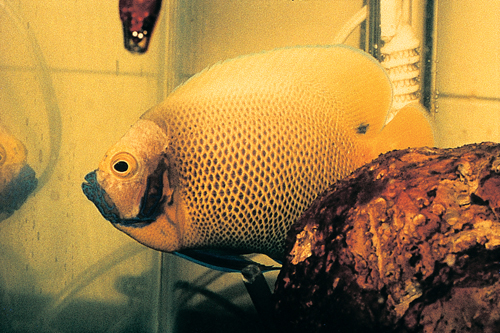Ornamental Fish Q&A 26
This marine angelfish has a chronic erosive lesion of the head around the eye. The entire area is depigmented and devoid of normal epidermis.
| Question | Answer | Article | |
| What is this condition called? | Head and lateral line erosion (HLLE). This is a chronic condition associated with negligible mortality. Affected fish usually have been in captivity at least several months. Tangs (Acanthuridae) and marine angelfish (Pomacanthidae) frequently display lesions. Gross inspection may reveal small pits in the epidermis around the head and lateral line progressing to large, usually nonhemorrhagic ulcers. These lesions are frequently without pigmentation and may extend the length of the lateral line. The disease is usually nonfatal but can result in permanent scarring. |
[[|Link to Article]] | |
| What are some probable causes of this syndrome? | The primary etiology of HLLE has not been discovered, although environmental stresses such as poor water quality, inadequate nutrition, and the presence of opportunistic pathogens appear to be involved. Recent reports of a reovirus isolated from a moribund angelfish displaying the initial lesions associated with HLLE may support the theory of an immunocompromised state existing in fish affected with HLLE. |
[[|Link to Article]] | |
| How would you manage this problem? | HLLE does not usually kill fish and affected individuals have been known to survive for years with only mild progression of clinical signs. For resolution of this condition, a change in husbandry is nearly always required. Improving nutrition combined with removing external stresses (aggressive tankmates, poor lighting, etc.) may arrest or even reverse the syndrome. Treatment with antimicrobials alone is unsuccessful; however, resolution of the lesions has been seen with vitamin-C supplementation or elimination of activated charcoal from the filtration systems. |
[[|Link to Article]] | |
